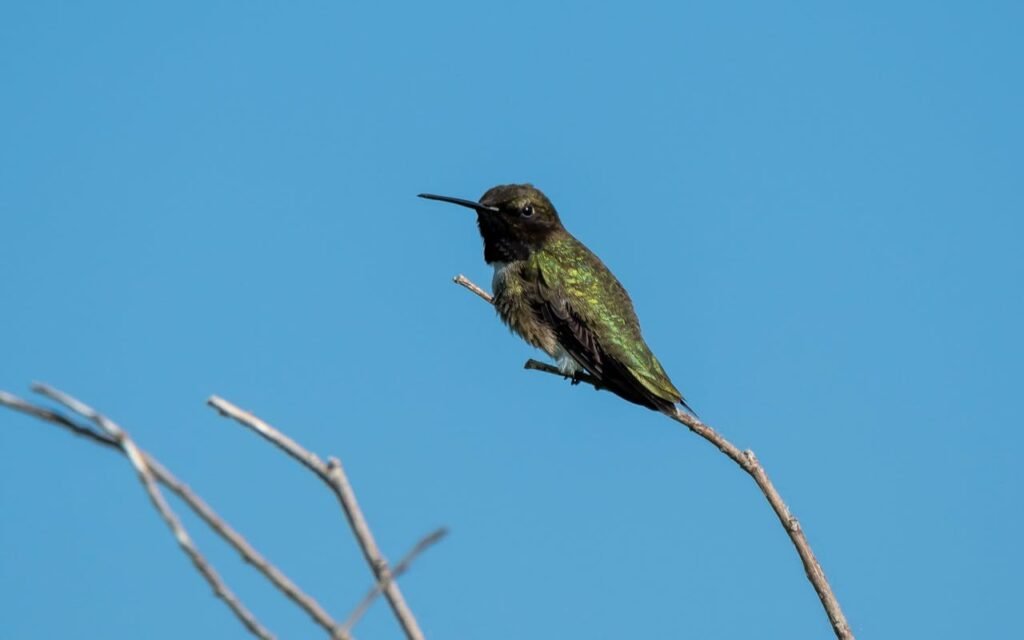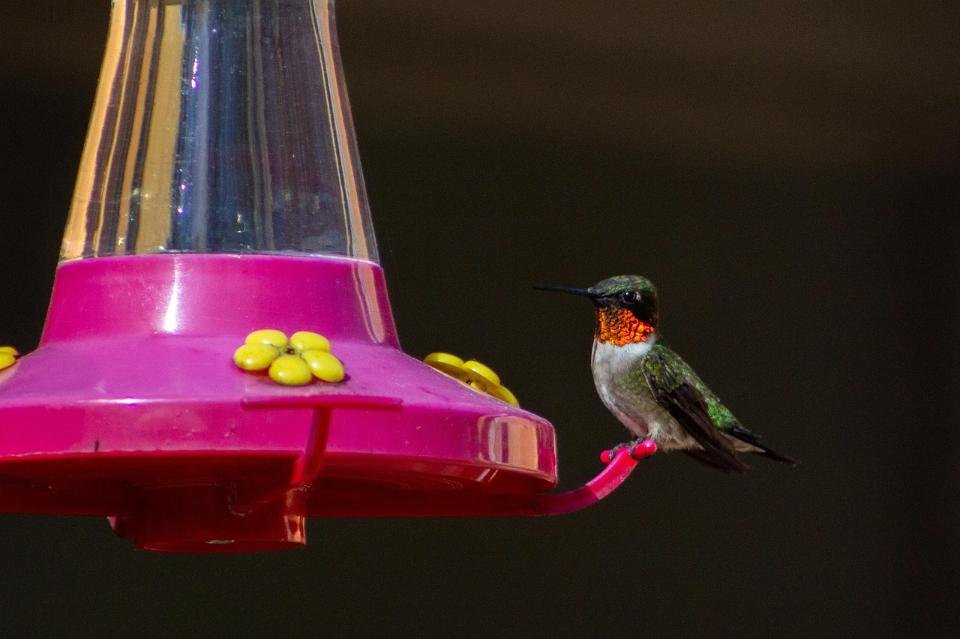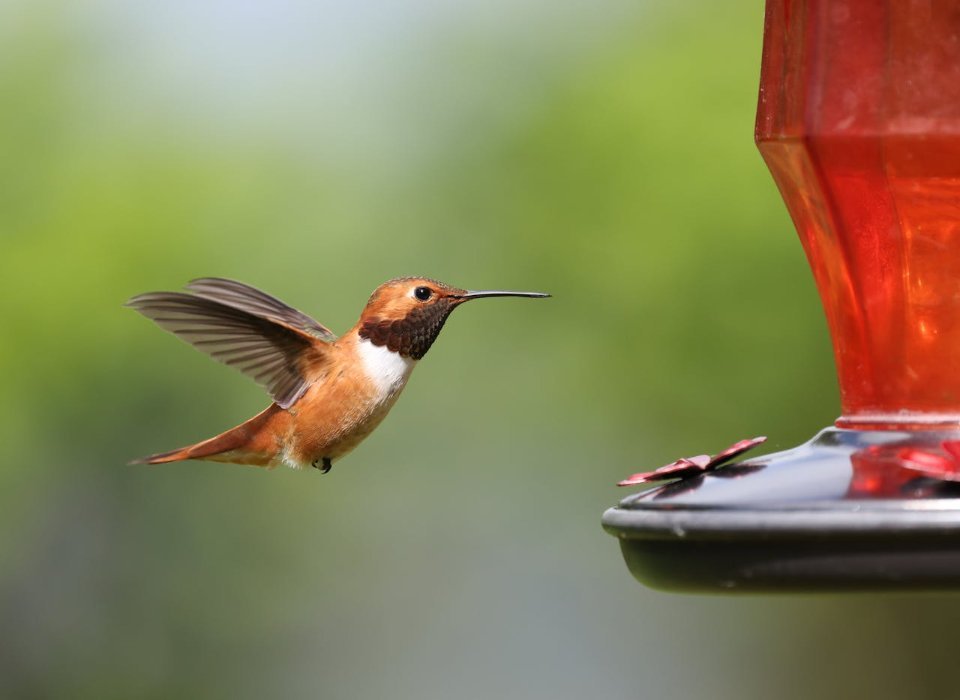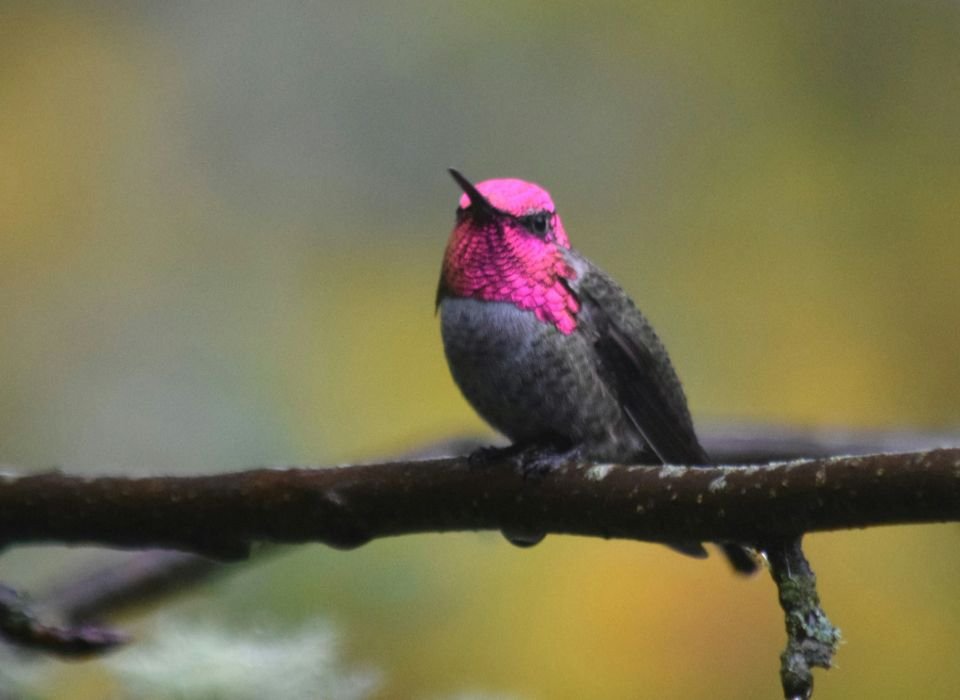One morning last September, I walked outside with my coffee and noticed something: the feeders were empty, and the air was silent. No buzzing, no territorial chatter, no tiny helicopters dive-bombing each other over sugar water rights. My hummingbirds had left, and I’d somehow missed saying goodbye 😮. If you’ve ever wondered when do hummingbirds migrate south, you’re not alone. The timing can feel mysterious, but once you understand the patterns, you’ll never miss the migration window again.
The truth is, hummingbird migration timing isn’t some random event. These birds follow ancient instincts triggered by day length, temperature changes, and food availability. Understanding when hummingbirds migrate south means you can prepare properly, help fuel their journey, and know exactly when to expect them back next spring. Let’s break down everything you need to know about fall hummingbird migration.
- Most hummingbirds migrate south between late July and October, depending on region.
- Males leave first (as early as July), followed by females and juveniles.
- Day length triggers migration, not food, so leaving feeders up won’t stop them from going.
- Ruby-throated Hummingbirds travel from Canada/US to Mexico and Central America.
- Some make a nonstop 500-mile flight across the Gulf of Mexico.
- Climate change and feeders are shifting migration timing slightly earlier and slower.
- Northern states see departures earlier, while southern states host migrants into November.
Overview of Hummingbird Migration
Hummingbirds are some of nature’s most impressive athletes. Despite weighing less than a nickel, they undertake migrations spanning thousands of miles. The most common species in eastern North America, the Ruby-throated Hummingbird, travels from as far north as Canada all the way to Central America. Some even make a nonstop 500-mile flight across the Gulf of Mexico. Yeah, you read that right: nonstop over open water.
According to the Cornell Lab of Ornithology, Ruby-throats are eastern North America’s sole breeding hummingbird. By early fall, they’re bound for Central America, where they’ll spend the winter months feeding in tropical forests and gardens. The entire journey is fueled by instinct, with day length serving as the primary trigger for migration.
Male hummingbirds typically leave first, sometimes departing as early as late July or early August. They’re not being rude or abandoning their families; males don’t participate in raising young, so once breeding season wraps up, they’re free to head south. Females and juveniles follow a few weeks later, once the young birds are strong enough for the journey.
Here’s what really gets me: hummingbirds don’t migrate in flocks. Each bird makes the journey solo, navigating by instinct and memory. They follow the same routes year after year, stopping at reliable food sources along the way. It’s like they have built-in GPS, except way more impressive because they weigh 3 grams.
When Do Hummingbirds Leave for the Winter?
The million-dollar question: when exactly do hummingbirds migrate south for the winter? The answer depends on several factors, including species, location, and individual bird timing. But we can definitely nail down some reliable patterns.
For most of the United States, fall hummingbird migration kicks off in late summer. According to research from Perky-Pet, Ruby-throated Hummingbirds usually start their fall migration in late August or September. Males leave first, followed by females, and finally the juveniles bringing up the rear.
The migration happens in waves rather than all at once. Early departees might leave in late July, while stragglers can linger into October or even early November in southern states. I’ve personally seen hummingbirds at my Texas feeder in mid-November, though by that point they’re usually late migrants passing through rather than locals.
Day length is the primary trigger for migration, not temperature or food availability. This means hummingbirds will leave even if your feeders are full and flowers are still blooming. Their internal clocks tell them it’s time to go, and they go. This is why you shouldn’t worry about keeping feeders up “too long” and preventing migration. That’s a myth; you’re just helping late migrants fuel up.
Interestingly, climate change is affecting migration patterns. A study published in The Auk found that Ruby-throated Hummingbirds are now arriving at breeding grounds 11.5 to 15 days earlier than they did historically, and their migration speed has actually slowed. Researchers suggest the increased availability of feeders along migration routes may be contributing to this leisurely pace.
IMO, this is fascinating stuff. These tiny birds are adapting their ancient migration patterns in real-time based on human-created food sources. Nature is incredibly flexible when it needs to be.
Regional Migration by State
When do hummingbirds migrate south in your specific state? Let’s break it down by region, because timing varies significantly depending on where you live.
Northeast: New York, Virginia, Maryland
If you’re wondering when do hummingbirds migrate south from New York, you’re looking at late August through September for most departures. The Northeast sees Ruby-throated Hummingbirds as their primary summer residents, and these birds typically begin their southward journey in late summer.
In New York, males start leaving around mid to late August. Females and juveniles follow through September, with the bulk of migration complete by early October. I’ve talked to birders in the Adirondacks who’ve seen their last hummingbirds as late as mid-October, but those are definitely stragglers.
For when hummingbirds migrate south from Virginia, the timeline shifts slightly later. Virginia’s more southern location means birds linger a bit longer, with peak migration happening from mid-September through early October. Virginia also sees a fair number of late migrants from farther north passing through, so your feeders might stay busy well into October.
Maryland follows a similar pattern to Virginia. When do hummingbirds migrate south from Maryland? Expect departures starting in late August for males, with peak migration in mid-September. According to Hummingbird Central, Ruby-throats gather along the Gulf Coast in September, preparing for their final push south, either over the Gulf or through Mexico.
The Northeast migration is relatively compressed compared to other regions. You’ve got maybe six to eight weeks from the first departees to the last stragglers, and then suddenly your summer is empty of hummingbirds. It hits differently every year :/
Midwest: Ohio, Michigan, Wisconsin, Illinois, Indiana, Minnesota, Missouri, Kansas
The Midwest experiences some of the earliest hummingbird departures in the country. When do hummingbirds migrate south from Michigan? Some birds from the Upper Midwest begin their journey as early as late July, particularly males that nested in northern Michigan or crossed into Canada.
Wisconsin and Minnesota follow similar patterns. These northern states see their first wave of southbound migrants in early to mid-August. By the time September arrives, most resident hummingbirds have already departed, though you might still see birds passing through from even farther north.
When do hummingbirds migrate south from Ohio, you’re looking at late August through September. Ohio sits in the middle latitudes, so it experiences both early departees and a steady stream of migrants from the Upper Midwest and Canada passing through. Peak migration typically happens during the first two weeks of September.
Illinois, Indiana, Missouri, and Kansas all see similar timing. Males leave in mid to late August, with females and juveniles following in September. According to information from Georgia Wildlife Resources, some ruby-throats from the Midwest and Northeast actually begin their migration as early as July. These are typically birds from the northernmost parts of their range.
Kansas, sitting at the western edge of Ruby-throat territory, sometimes sees different species passing through as well. Rufous Hummingbirds migrating down from the Pacific Northwest occasionally show up at Kansas feeders in fall, adding some variety to the usual Ruby-throat parade.
One thing I’ve noticed talking to Midwestern birders: they often see a surge in hummingbird activity right before migration kicks off. Birds pack on weight frantically, visiting feeders constantly and becoming less territorial than usual. It’s like watching them carb-load before a marathon.
South: Texas, Tennessee, Oklahoma
Southern states have more complex migration patterns because they’re both departure points for local breeders and stopover sites for birds traveling from farther north. So when do hummingbirds migrate south from Texas? It depends which part of Texas you’re in and whether you’re talking about local breeders or migrants.
East Texas, where Ruby-throated Hummingbirds breed, sees local birds departing in September. But the state also hosts massive numbers of migrants from across the eastern United States. According to Hummingbird Central, Ruby-throats gather along the South Texas coast in September, preparing for their Gulf crossing. This means Texas feeders can stay busy from August well into October.
West Texas and the Hill Country sometimes host different species, including Black-chinned Hummingbirds and occasional Rufous Hummingbirds migrating down the Rocky Mountain corridor. The hummingbird migration timing in western Texas can extend from late July through October, depending on species.
Tennessee sits in an interesting position geographically. When do hummingbirds migrate south from Tennessee? Local breeders start leaving in late August, but Tennessee also serves as a migration corridor for birds from the upper South and lower Midwest. Peak migration happens in September, with feeders staying active through early October.
Oklahoma follows a similar pattern. When do hummingbirds migrate south from Oklahoma, expect August through September for most departures, with continued activity from migrants passing through. Oklahoma’s central location means it sees waves of birds from multiple regions all funneling through on their way to the Gulf Coast.
The South is honestly the most exciting region for hummingbird watching during fall migration. You get this convergence of birds from all over the eastern United States, all headed for the same general destination. It’s like O’Hare Airport for hummingbirds, except with better food and fewer delays 🙂
West: California, Arizona, and the Pacific Northwest
Western migration patterns differ significantly from the East because different species dominate. The West Coast hosts several hummingbird species, and not all of them migrate.
Anna’s Hummingbirds, according to the American Bird Conservancy, don’t migrate at all. They’re year-round residents along the Pacific Coast from British Columbia down through California. If you live in coastal California and see hummingbirds at your feeder in January, they’re probably Anna’s.
Rufous Hummingbirds are the migration champions of the West. These feisty little birds breed as far north as Alaska and migrate all the way down to southern Mexico. They typically start their southward journey in July, traveling down the Rocky Mountain corridor and hitting Arizona and New Mexico by August and September. Research from Perky-Pet indicates that Rufous Hummingbirds winter in southern Mexico and make their spring migration up the Pacific Coast.
Arizona serves as a major migration corridor and hosts several resident species as well. The timing there can be complex, with different species coming and going at different times. Generally, August through October is peak fall migration season for most species.
Signs That Hummingbirds Are About to Migrate
How do you know when your hummingbirds are getting ready to leave? There are several telltale signs if you know what to watch for. Rufous Hummingbird
First, increased feeding activity. In the weeks leading up to migration, hummingbirds visit feeders with increased frequency. They’re trying to pack on as much weight as possible, building fat reserves that will fuel their journey. A hummingbird can gain 25-40% of its body weight in preparation for migration. That’s like a 150-pound person bulking up to 210 pounds in a few weeks. Impressive and slightly terrifying.
You’ll also notice decreased territoriality. During breeding season, hummingbirds are aggressive little things, constantly chasing each other away from feeders and flowers. As migration approaches, they become more tolerant of each other. The need to feed outweighs the urge to defend territory, so you might see multiple birds feeding peacefully at the same feeder.
Males disappear first. If you’ve been watching specific birds (maybe one with a particularly bright gorget or distinctive behavior), you might notice the males vanish in late summer while females and younger birds stick around. This staggered departure is normal and happens every year.
Finally, you’ll see an increase in unfamiliar birds. As migrants from farther north pass through your area, you might notice your feeders getting busier than usual, or see birds with slightly different behaviors. These are travelers stopping to refuel before continuing their journey south.
One year, I had 15 hummingbirds at my feeders simultaneously in mid-September, when I usually have maybe 3-4 during summer. I knew I was seeing migrants passing through, and it was honestly magical watching this parade of tiny travelers.
How to Help Hummingbirds During Migration
Want to support hummingbirds during their incredible journey? Here’s how you can actually make a difference.
Keep your feeders up and filled. The biggest myth in hummingbird feeding is that leaving feeders up will prevent migration. This is completely false. Day length triggers migration, not food availability. By keeping feeders up through October (or even into November in southern states), you’re helping late migrants and stragglers fuel up for their journey. Change the sugar water every 3-5 days to keep it fresh.
Plant native flowers that bloom in fall. Hummingbirds prefer natural nectar sources, and late-blooming flowers provide essential nutrition. Salvia, cardinal flower, trumpet creeper, and jewelweed are all excellent late-season options. Native plants also attract the small insects that hummingbirds need for protein.
Provide multiple feeding stations. During migration, you might have more birds than usual visiting your yard. Multiple feeders reduce competition and ensure every bird gets enough food. Space them far enough apart that dominant birds can’t guard them all.
Avoid pesticides. Hummingbirds eat significant numbers of small insects and spiders, which provide essential protein and fat. Pesticides reduce insect populations and can poison birds directly or through contaminated prey. Keep your yard as chemical-free as possible.
Report your sightings. Citizen science projects like Journey North and eBird track hummingbird migration in real-time. Your observations help researchers understand migration patterns, timing changes, and population trends. It takes two minutes to log a sighting, and the data is genuinely valuable.
Research published in Ecological Applications examined how hummingbird migration synchronizes with flowering patterns, highlighting the importance of maintaining nectar corridors along migration routes. Every feeder and native plant garden contributes to these essential corridors.
Where Do Hummingbirds Go in Winter?
Ever wondered where hummingbirds go in winter after they leave your yard? The answer depends on species, but for Ruby-throated Hummingbirds, the destination is Mexico and Central America.
Most Ruby-throats winter in southern Mexico, particularly the Yucatan Peninsula, and in Central American countries including Guatemala, Belize, Honduras, Costa Rica, and Panama. They spend the winter months feeding in tropical forests, gardens, and forest edges where flowering plants provide year-round nectar.
The journey to get there is remarkable. According to Journey North, many Ruby-throated Hummingbirds make a nonstop flight of 500 miles or more across the Gulf of Mexico. They fly for 18 to 24 hours without rest, burning through their carefully accumulated fat reserves. Some birds take an overland route following the coastline through Texas and Mexico, but the Gulf crossing is actually faster if conditions are favorable.
Rufous Hummingbirds winter in southwestern Mexico, Guatemala, and Belize. Black-chinned Hummingbirds head to Mexico as well. Meanwhile, some species like Anna’s Hummingbirds don’t migrate at all, remaining year-round along the Pacific Coast.
What do they do all winter? Pretty much the same thing they do here: feed, defend territories, and prepare for the return journey north. Winter isn’t really a vacation for hummingbirds. It’s just survival in a different location with more reliable food sources.
Interestingly, according to data from Hummingbird Central, some hummingbirds are overwintering on the Gulf Coast in greater numbers than in the past. Climate change and the proliferation of feeders may be enabling some birds to winter farther north than historically typical. This doesn’t mean they’re not migrating; it just means some individuals are cutting their journey short.
FAQs About Hummingbird Migration
Should I take down my feeders to force hummingbirds to migrate?
Absolutely not. This myth needs to die. Hummingbirds migrate based on day length, not food availability. Leaving feeders up helps late migrants and stragglers. In fact, keep them up for at least two weeks after you see your last hummingbird, just in case.
Do hummingbirds migrate at night?
Most hummingbirds migrate during the day when they can see flowers and feeders for refueling. However, birds making the Gulf crossing or other long overwater flights may fly through the night to complete their journey.
How fast do hummingbirds fly during migration?
During regular flight, hummingbirds cruise at about 25-30 mph. With tailwinds during migration, they can reach speeds of 60 mph. They can’t sustain their famous 60+ mph dive speeds for long distances.
Can young hummingbirds really migrate alone without being taught?
Yes! Migration is entirely instinctual. Juvenile hummingbirds make their first migration solo, having never seen the route before. They navigate using a combination of the sun’s position, magnetic fields, and possibly landmarks. It’s mind-blowing when you think about it.
Why do males leave before females?
Males don’t participate in raising young, so once breeding season ends, they’re free to leave. Females stay until their young are independent, which delays their departure by several weeks. This staggered migration also reduces competition for food resources along the route.
Conclusion
Understanding when hummingbirds migrate south transforms how you experience these remarkable birds. It’s not just about enjoying them while they’re here; it’s about appreciating the incredible journey they undertake twice a year. From the first departures in late July to the last stragglers in October or November, fall hummingbird migration is a season-long event worth paying attention to.
The timing varies by region, with northern states seeing earlier departures and southern states hosting both local breeders and migrants passing through. But across the board, late August through September is when most of the action happens. Males leave first, females and juveniles follow, and before you know it, your summer companions have vanished into the south.
Next year, pay closer attention to the signs. Watch for increased feeding activity, decreased aggression, and the gradual disappearance of familiar faces. Keep your feeders full through the migration window, plant some late-blooming natives, and maybe log your sightings with a citizen science project. Every little bit helps these tiny athletes complete their incredible journey.
And when that morning comes when you walk outside to silence and empty feeders, you won’t feel like you missed saying goodbye. You’ll know they left right on schedule, following instincts millions of years old, headed for tropical forests where they’ll spend the winter preparing for their return. They’ll be back in spring, right when the first flowers bloom and you’ve got your feeders clean and ready.
I’m already counting down the days until next March. These birds may be tiny, but man, do they leave a big hole when they go.





